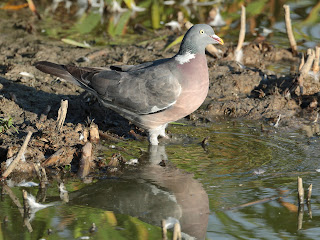The aim of bird photography in my opinion is to get a sharp detailed shot of the entire bird, this means in an ideal world having the light behind you, the bird to be perched, nicely posed with an un cluttered foreground and a lovely bokeh in the background, as in the Stonechat picture below, its a lot to ask but it does happen and when it does and you nail the shot, well it doesn't get much better than that.
Canon 5dmk3 700mm 1\640th f9 iso320
Taken at Pegwell Bay Country Park 2016
Taken at Pegwell Bay Country Park 2016
There is a small white dot on her eye from the tip of her beak to this dot is 51mm.
Some photographers say focus on the eye, get the eye sharp and the rest will be fine, others say focus down the body, well lets put the theory to the test, the testing below will hopefully prove where the best point of focus is to achieve tac sharp results.
One of the Layzee golden rules is always check your settings, nothing worse than having a once in a lifetime shot spoilt because you forgot to put your settings back to normal, check them often ! I say this through experience !!
OK so the setup is as follows, Alice is sitting approx 6m from the camera and approx 45 degree angle across the field of view with the tip of her beak closest to the camera, we have a lovely sunny day, I am using my Canon EF 500mm f4 L IS on my 5dmk4, tripod with gimbal head.
The only setting I am changing is going to be the f stop, I am using AV mode which means the shutter speed will change according to the light conditions as each shot is taken, iso100 is set for the duration.
I have also adjusted the exposure to compensate for the white background +1ev for all the shots.
I have taken shots at f4, f7.1, f14, f18.
I have taken 2 shots at each aperture setting one with the focal point on the eye the other with the focal point on her left leg underneath the body (as you look at her).
Baring in mind that our DOF will be approx 50% in front and 50% behind the actual focal point (unless you have dialled in some front or back bias) and knowing that from the centre of the eye to the tip of the beak is nearly 51mm to ensure we have the tip of the beak in sharp focus we need a total DOF of 110mm, we also know it is about 6m from the camera to Alice.
Using the above with a DOF calculator the ideal f stop focusing on the eye would be f14.
OK so first up is f4 focusing on the eye a lot of photographers shoot wide open for the fastest shutter speed in this case f4.
f4 eye
f4eye_cr.jpg
The above link will display the full size image in a new window so that the detail can be seen, I have added links below all the images as views on the blog are restricitve.
f4eye_cr.jpg
The above link will display the full size image in a new window so that the detail can be seen, I have added links below all the images as views on the blog are restricitve.
Tac sharp on the eye but we can clearly see that the DOF is so shallow (3.17cm) that only a very thin slice of Alice is sharp, the rest is in my opinion unacceptably soft.
As the DOF is so shallow it doesn't matter where you focus you are not going to get all of Alice sharp.
Next up is f7.1 again focal point is the eye, total DOF of 5.65cm.
Still we see at f7.1 that the tip of the beak is not sharp, also the tips of the wing and tail are also still out of focus, using the top of the leg for the focal point makes little difference the tail is nice and sharp but the beak is not.
OK now lets jump to f14 again the focal point is the eye, which according to our DOF calculator gives us a total DOF of 11.29cm, this should be the sweet spot for Alice to be caught in all her glory.
Next up is f14 focal point is the leg, this is to me is acceptible, the tip of the beak is a little soft if I am picky about it and the tail feathers are still a little soft, but overall Id choose this over the shot above
f18 looks like the best fit to me total DOF of 14.23cm again focal point of the eye, this looks to be sharp front to back which is what we are trying to achieve
f18 with focal point of the leg doesnt look quite as crisp and sharp as the shot taken using the eye as the focal point.
In summary it would appear that for Alice the best focal point is indeed the eye that said however if you were to apply the same principal to a Long Tailed Tit you would never get the tail sharp due to the distance from the centre of the eye to the end of the beak on a LTT being 15mm at a guess.
It would seem to me like there is no difinitive correct way, its all a matter of experience, the orientation of the bird, its size etc and above all what works for you, you need to assess each shot on a shot by shot basis and apply what you have learnt via experience out in the field, after all that is the best classroom.
Sometimes our results are disappointing but that is how we learn, another Layzee golden rule dont be afraid to ask, for those that dont ask dont get !



















































